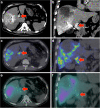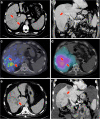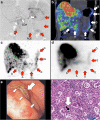Post-radioembolization yttrium-90 PET/CT - part 1: diagnostic reporting
- PMID: 23883566
- PMCID: PMC3726297
- DOI: 10.1186/2191-219X-3-56
Post-radioembolization yttrium-90 PET/CT - part 1: diagnostic reporting
Abstract
Background: Yttrium-90 (90Y) positron emission tomography with integrated computed tomography (PET/CT) represents a technological leap from 90Y bremsstrahlung single-photon emission computed tomography with integrated computed tomography (SPECT/CT) by coincidence imaging of low abundance internal pair production. Encouraged by favorable early experiences, we implemented post-radioembolization 90Y PET/CT as an adjunct to 90Y bremsstrahlung SPECT/CT in diagnostic reporting.
Methods: This is a retrospective review of all paired 90Y PET/CT and 90Y bremsstrahlung SPECT/CT scans over a 1-year period. We compared image resolution, ability to confirm technical success, detection of non-target activity, and providing conclusive information about 90Y activity within targeted tumor vascular thrombosis. 90Y resin microspheres were used. 90Y PET/CT was performed on a conventional time-of-flight lutetium-yttrium-oxyorthosilicate scanner with minor modifications to acquisition and reconstruction parameters. Specific findings on 90Y PET/CT were corroborated by 90Y bremsstrahlung SPECT/CT, 99mTc macroaggregated albumin SPECT/CT, follow-up diagnostic imaging or review of clinical records.
Results: Diagnostic reporting recommendations were developed from our collective experience across 44 paired scans. Emphasis on the continuity of care improved overall diagnostic accuracy and reporting confidence of the operator. With proper technique, the presence of background noise did not pose a problem for diagnostic reporting. A counter-intuitive but effective technique of detecting non-target activity is proposed, based on the pattern of activity and its relation to underlying anatomy, instead of its visual intensity. In a sub-analysis of 23 patients with a median follow-up of 5.4 months, 90Y PET/CT consistently outperformed 90Y bremsstrahlung SPECT/CT in all aspects of qualitative analysis, including assessment for non-target activity and tumor vascular thrombosis. Parts of viscera closely adjacent to the liver remain challenging for non-target activity detection, compounded by a tendency for mis-registration.
Conclusions: Adherence to proper diagnostic reporting technique and emphasis on continuity of care are vital to the clinical utility of post-radioembolization 90Y PET/CT. 90Y PET/CT is superior to 90Y bremsstrahlung SPECT/CT for the assessment of target and non-target activity.
Figures







References
-
- Salem R, Thurston KG. Radioembolization with yttrium-90 microspheres: a state-of-the-art brachytherapy treatment for primary and secondary liver malignancies: part 3: comprehensive literature review and future direction. J Vasc Interv Radiol. 2006;3:1571–1593. doi: 10.1097/01.RVI.0000236744.34720.73. - DOI - PubMed
-
- Sirtex Technology Pty Ltd, Lane Cove. Pilot study of Selective Internal Radiation Therapy (SIRT) with yttrium-90 resin microspheres (SIR-Spheres microspheres) in patients with renal cell carcinoma (STX0110, “RESIRT”) New South Wales, Australia: Australiancancertrials.gov.au; 2010. Trial ID ACTRN12610000690055.
-
- Muylle K, Nguyen J, de Wind A, Meuleman N, Delatte P, Vanderlinden B, Roelandts M, Van der Stappen A, Bron D, Flamen P. Radioembolization of the spleen: a revisited approach for the treatment of malignant lymphomatous splenomegaly. Cardiovasc Intervent Radiol. 2013;3:1155–1160. doi: 10.1007/s00270-012-0484-z. - DOI - PubMed
LinkOut - more resources
Full Text Sources
Other Literature Sources

